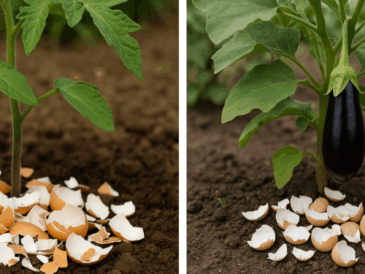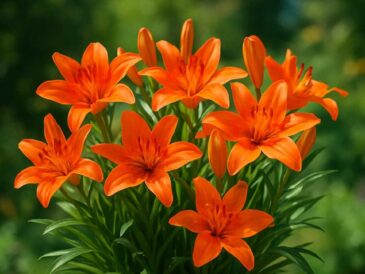Aphids – those tiny green, black, or white pests that cluster on plant stems and leaves – can quietly wreak havoc in your garden.
They suck sap, distort new growth, and spread diseases between plants. If you’ve ever seen curled leaves or sticky residue (honeydew) on your plants, aphids are likely the cause.
But before reaching for chemical sprays, there’s a safer, greener, and longer-lasting solution – plants that naturally repel aphids.
Why Use Plants to Repel Aphids
Companion planting – growing pest-repelling plants near vulnerable crops – creates a natural balance in your garden ecosystem.
Plants that repel aphids help by:
- Masking scent signals: Aphids locate plants by smell; strong aromatic herbs confuse them.
- Attracting predators: Some plants draw beneficial insects that feed on aphids.
- Producing defensive compounds: Natural oils and alkaloids act as mild insect repellents.
This method keeps your garden free from chemicals, safer for pollinators, and more sustainable in the long run.
1. Marigolds (Tagetes spp.)
Marigolds are classic garden protectors. Their strong, pungent scent repels aphids, nematodes, and even whiteflies. The roots release alpha-terthienyl, a compound toxic to soil pests.
Best Use: Plant marigolds near tomatoes, peppers, or roses – plants aphids love. They’ll form a colorful barrier that keeps pests away while attracting pollinators.
Extra Benefit: Marigolds bloom continuously through summer, brightening your garden while keeping it healthy.
2. Garlic (Allium sativum)
Garlic emits a strong sulfuric odor that aphids can’t stand. It confuses their sense of smell and drives them away from nearby plants.
Best Use: Interplant garlic with roses, lettuce, and fruit trees. You can also make a simple garlic spray (crushed cloves soaked in water) to mist aphid-infested leaves.
Extra Benefit: Garlic’s scent also deters ants – which often protect aphids for their honeydew.
3. Chives (Allium schoenoprasum)
Closely related to garlic, chives are another excellent anti-aphid herb. Their onion-like aroma keeps aphids and mites at bay, especially when planted near roses or tomatoes.
Best Use: Grow chives in pots or borders near plants that tend to attract aphids. When they bloom, the purple flowers attract bees and other beneficial insects.
Extra Benefit: You can harvest the leaves for soups and salads while they protect your plants.
4. Nasturtiums (Tropaeolum majus)
Nasturtiums work as a “trap crop” – meaning aphids prefer them over your vegetables. Instead of infesting your tomatoes or beans, aphids will gather on the nasturtium leaves, leaving your main crops unharmed.
Best Use: Plant nasturtiums along garden edges or beneath fruit trees. Once aphids gather on them, you can simply trim off the affected leaves.
Extra Benefit: Their edible flowers add color to salads and attract pollinators like butterflies.
5. Lavender (Lavandula angustifolia)
The strong fragrance of lavender overwhelms the scent signals that attract aphids. Its essential oils naturally repel many insects, including moths, fleas, and mosquitoes.
Best Use: Plant lavender around the perimeter of vegetable gardens or near roses. Aphids dislike it, but bees love it – creating a balanced ecosystem.
Extra Benefit: Lavender’s scent also relaxes the mind, so your garden smells as beautiful as it looks.
6. Mint (Mentha spp.)
Mint releases menthol and other aromatic oils that confuse aphids and deter ants. It’s best used in containers, as it spreads aggressively.
Best Use: Place pots of mint near your most vulnerable crops, such as kale, cabbage, and peas.
Extra Benefit: Crush a few leaves to release the aroma – it’s refreshing for you, unbearable for aphids.
7. Basil (Ocimum basilicum)
Basil not only enhances your cooking but also your garden health. Its strong, spicy aroma drives away aphids, mosquitoes, and whiteflies.
Best Use: Grow basil beside tomatoes, peppers, or beans. Both plants benefit – basil repels pests, and tomatoes help shade basil’s roots.
Extra Benefit: Harvest leaves regularly to encourage more growth and stronger pest protection.
8. Catnip (Nepeta cataria)
Catnip is one of the most effective natural insect repellents. It contains nepetalactone, a compound that repels aphids, fleas, and even cockroaches.
Best Use: Plant catnip near squash, potatoes, and beans – aphid-prone crops. Keep in mind cats might be drawn to it, so choose your placement wisely.
Extra Benefit: It attracts lacewings, which are voracious aphid predators.
9. Dill (Anethum graveolens)
Dill does double duty – it repels aphids while attracting ladybugs and parasitic wasps that feast on them.
Best Use: Scatter dill among cabbages, cucumbers, and lettuces. Its delicate leaves and yellow flowers add beauty to the garden.
Extra Benefit: It’s edible, aromatic, and self-seeds easily – perfect for organic gardeners.
10. Fennel (Foeniculum vulgare)
Fennel’s strong anise scent deters aphids, snails, and slugs. Its feathery leaves attract beneficial insects, creating a balanced pest ecosystem.
Best Use: Plant fennel at garden borders rather than directly among crops – it can compete with neighboring plants for nutrients.
Extra Benefit: Butterflies love fennel, making it both functional and ornamental.
11. Oregano (Origanum vulgare)
Oregano acts as a ground cover and pest deterrent. Its scent drives away aphids and spider mites, while attracting hoverflies – another aphid predator.
Best Use: Grow oregano near peppers, eggplants, and broccoli. It thrives in full sun and dry soil.
Extra Benefit: A low-maintenance herb that adds both flavor and protection to your garden.
12. Rosemary (Rosmarinus officinalis)
Rosemary emits powerful aromatic oils that repel aphids, cabbage moths, and carrot flies. It’s especially effective in hot, sunny areas.
Best Use: Plant rosemary near beans, carrots, or cabbage. You can also grow it in containers and move it around to protect different areas.
Extra Benefit: A hardy perennial that adds beauty and fragrance year-round.
How to Use These Plants Effectively
To get the most from your natural aphid-repelling plants:
- Combine multiple plants: A mix of aromatic herbs, flowers, and trap crops confuses pests better than one plant alone.
- Rotate planting areas: Moving pest-repelling plants each season prevents aphid adaptation.
- Encourage predators: Add flowers like yarrow, dill, and alyssum to invite ladybugs, lacewings, and hoverflies.
- Avoid over-fertilizing: Soft, nitrogen-rich growth attracts aphids – balance your soil organically.
- Companion plant wisely: Place repellents around plants aphids love most – roses, beans, lettuce, tomatoes, and brassicas.
Bonus: Homemade Aphid Spray with Repelling Plants
You can also make a natural aphid repellent spray using the same plants:
Ingredients:
- 5–6 garlic cloves
- A handful of mint or basil leaves
- 1 teaspoon mild soap
- 4 cups water
Instructions:
- Crush the garlic and mint leaves.
- Boil them in water for 10 minutes, then let cool.
- Strain and mix in the soap.
- Spray directly on aphid-infested leaves (undersides included).
Repeat every few days until the infestation subsides.
Aphids might be tiny, but they can cause major garden damage if left unchecked. Fortunately, nature offers elegant solutions.




